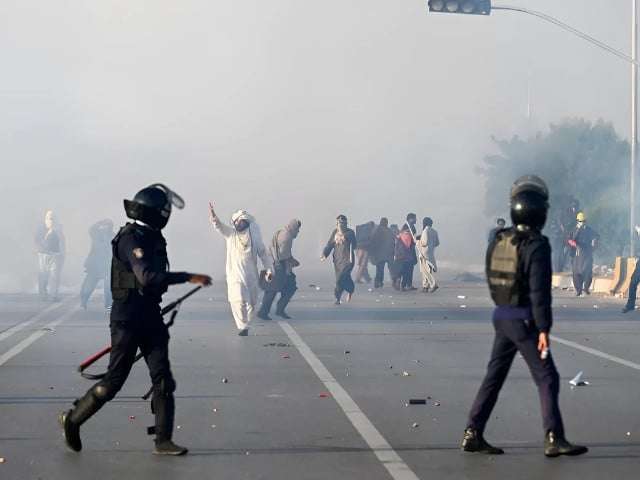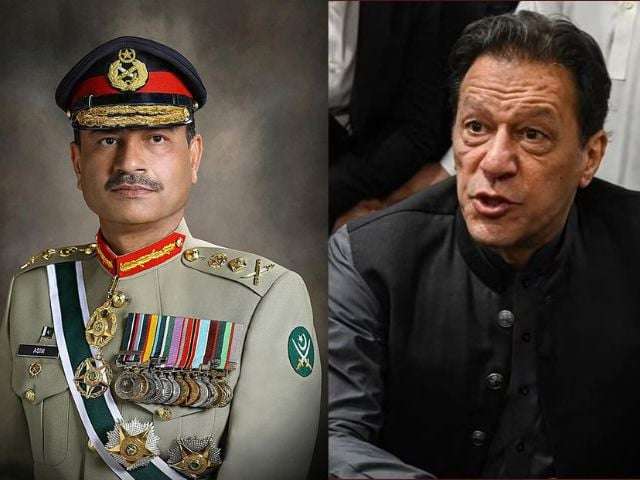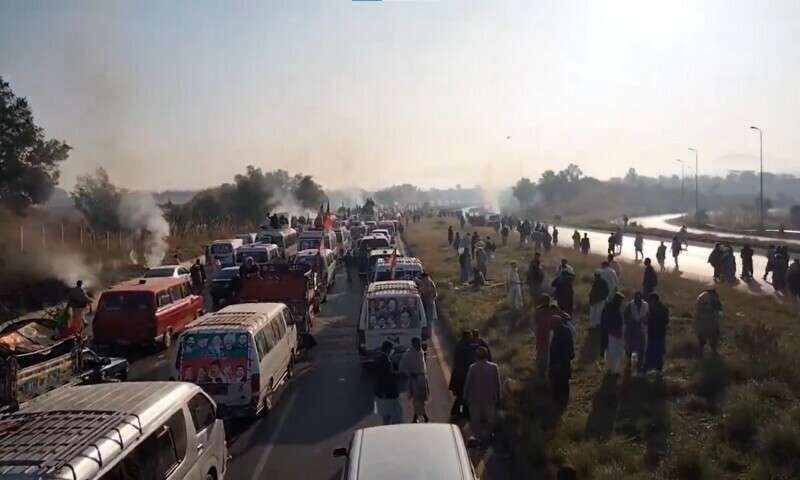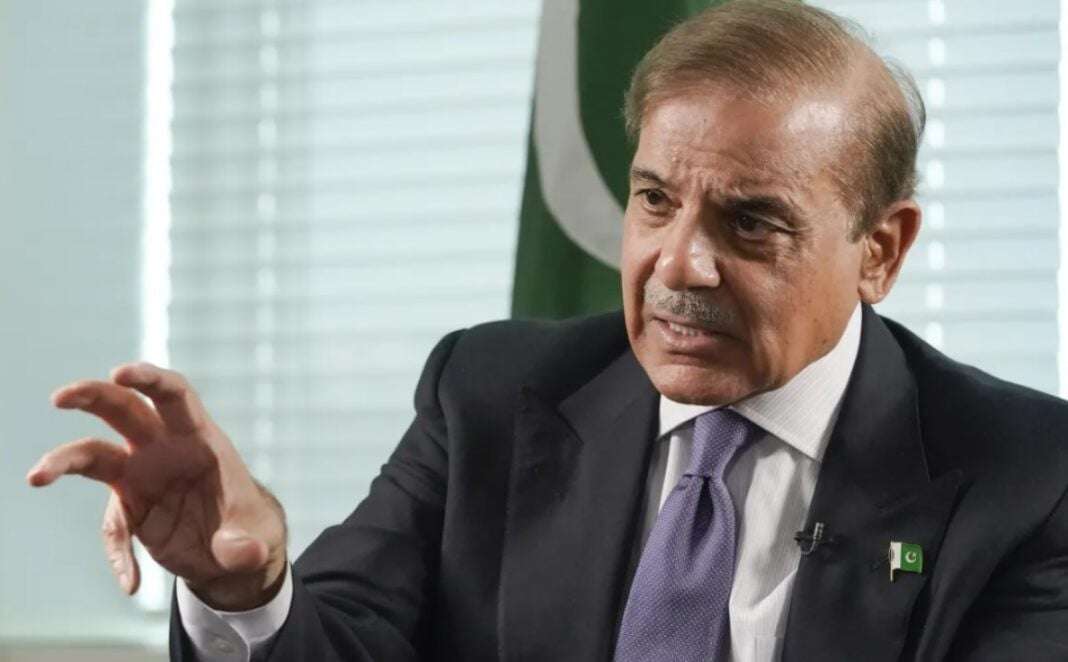Introduction: A Political Standoff in Pakistan
Tensions in Pakistan have reached a boiling point as protests led by the opposition party, Pakistan Tehreek-e-Insaf (PTI), have escalated into violent clashes with security forces. The protests, spearheaded by Bushra Bibi, the wife of former Prime Minister Imran Khan, have reached the heart of Islamabad, with the PTI convoy nearing Zero Point. In response to the growing unrest, the Pakistan Army has been deployed across the capital city, with orders for extreme measures, including the potential for shoot-on-sight actions.
The Pakistan Ministry of Interior’s decision to deploy the military under Article 245 of the Constitution reflects the seriousness of the situation. The atmosphere in Islamabad is charged, with the presence of military personnel and increased security measures in place. This article will delve deeper into the unfolding events, the political motivations behind the protests, and the government’s response.
The March and Rising Clashes
The situation began to spiral out of control earlier in the day, as PTI workers gathered in Islamabad in large numbers. The protesters, determined to press for their demands, faced off with police and military forces, resulting in violent clashes. As the PTI convoy, led by Bushra Bibi, approached the Zero Point, it became clear that the situation was deteriorating rapidly.
In response to the growing unrest, the government had already activated the Pakistan Army under Article 245, which grants the military sweeping powers to maintain order during times of civil unrest. By this time, key government buildings were being guarded by Rangers, and military personnel were stationed at strategic points, including D-Chowk.
Military Presence and ‘Shoot-on-Sight’ Orders
In an unprecedented move, authorities authorized extreme measures to deal with the growing violence. According to official reports, military personnel were given ‘shoot on sight’ orders to deter the protesters from advancing further. This decision came after clashes between PTI supporters and law enforcement agencies had intensified.
The use of tear gas and rubber bullets had already begun, but the government was concerned about the risk of further escalation. As a result, a heavy presence of both police and military units was established to prevent the protesters from entering the sensitive Red Zone of Islamabad, which houses key government buildings.
The Tragic Loss of Life: Rangers Martyred
The violence took a tragic turn earlier when protesters rammed a vehicle into a group of Rangers personnel on the Srinagar Highway in Islamabad. The attack resulted in the martyrdom of four Rangers officials and two policemen, heightening the already volatile situation. The tragic loss of life led to an increase in the government’s resolve to quash the protests with force if necessary.
Simultaneously, there were reports of armed protesters throwing stones and opening fire on security forces at various locations, including Rawalpindi. A Ranger was injured in these clashes and was rushed to the hospital in critical condition.
Strategic Response: A Call for Action
Interior Minister Mohsin Naqvi addressed the media, warning PTI protestors that any attempt to breach the Red Zone in Islamabad would not be tolerated. The minister emphasized that the government had offered PTI an alternative venue for their protest, at Sangjani, away from the capital’s most sensitive areas. However, PTI insisted on holding their protest at D-Chowk, a location that the government deemed off-limits for any public demonstrations.
Naqvi made it clear that the government’s response would be firm, stating that “if the PTI protests cross the Red Line, extreme measures will be taken, including the imposition of curfews and the use of force.” He also hinted at the potential invocation of Article 245, which allows the military to take over law enforcement duties in extreme cases.
Negotiations and Talks with Imran Khan
While the protests were continuing to unfold on the streets of Islamabad, efforts were underway to de-escalate the situation through diplomatic channels. A significant meeting took place between Imran Khan, the founder of PTI, and senior party leaders. Barrister Gohar Khan, a key figure in the PTI, confirmed that the protests would continue as planned, with no plans to back down until the party’s demands were met.
The PTI’s demands, which include the release of political prisoners, a reversal of the 26th Constitutional Amendment, the restoration of democracy, and the return of an alleged “stolen mandate,” remain unchanged. The party’s leadership has made it clear that they will not accept anything less than these fundamental changes.
Government’s Response: Containment Measures
In anticipation of further violence, the government imposed several security measures across Islamabad and neighboring cities. Section 144 was invoked, which temporarily bans public gatherings in certain areas. In addition, the government took the extraordinary step of placing shipping containers at key entry points to the capital, effectively blocking all roads leading to Islamabad.
These security measures, while effective in limiting the movement of protesters, caused significant disruption across the region. The twin cities of Islamabad and Rawalpindi, as well as many other cities in Punjab, were brought to a standstill due to the roadblocks. Businesses were forced to close, and people were unable to travel freely due to the barricades.
The Shutdown of Internet Services
In an effort to prevent coordination among protestors, the government decided to restrict internet services in certain areas of Islamabad. Wi-Fi and mobile internet were temporarily shut down in areas deemed to be high-risk, including Aabpara, where the tear gas shelling had caused businesses to shut down. In addition, authorities made moves to block access to social media platforms, such as WhatsApp, in an attempt to curb the spread of information that could mobilize more people.
The restrictions were part of a broader strategy by the government to contain the protest and prevent any further escalation. Internet monitoring organizations reported disruptions in connectivity, with some areas experiencing complete service outages.
Arrests and Detentions: Tightening the Grip
The government’s crackdown on PTI supporters continued throughout the day, with reports of arrests across various provinces. Key PTI leaders, including Amir Dogar, the party’s chief whip in the National Assembly, and Zain Qureshi, were arrested from Multan. In total, around 600 people were detained for violating Section 144, according to the Punjab police.
Despite these efforts, many PTI supporters managed to evade the authorities and continued their march towards Islamabad. The protests, which had started in various provinces, including Khyber-Pakhtunkhwa, Punjab, and Sindh, showed no signs of abating.
The Growing Political Divide
The ongoing protests have exacerbated the political divide in Pakistan. On one side, PTI supporters remain steadfast in their demand for Imran Khan’s release and the restoration of democracy. On the other, the ruling government, led by the Pakistan Muslim League-Nawaz (PML-N), has warned that any disruption in the capital will not be tolerated. The government’s hardline stance has been reinforced by the visit of Belarus President Alexander Lukashenko, making it clear that no political instability will be allowed during his visit.
The protests have also drawn international attention, as the political crisis in Pakistan continues to unfold. The country’s future remains uncertain as the government and opposition stand firm in their positions.
Conclusion: A Nation on the Edge
Pakistan is at a critical juncture as the PTI protests intensify and the government mobilizes its forces to maintain order. The military’s presence, combined with the government’s tough stance, signals a potential for further conflict. However, both sides appear unwilling to back down, and the outcome remains uncertain.
As the situation continues to evolve, the world watches closely. The government’s efforts to block the protests and control the narrative through media restrictions have sparked widespread debate. The fate of Pakistan’s democracy and political stability hangs in the balance, as the nation grapples with its internal divisions.
Frequently Asked Questions (FAQs)
1. Why was the Pakistan Army deployed in Islamabad?
The Pakistan Army was deployed under Article 245 of the Constitution in response to escalating security concerns following violent clashes between PTI supporters and security forces.
2. What are PTI’s main demands?
PTI is demanding the release of political prisoners, reversal of the 26th Constitutional Amendment, restoration of democracy, and the return of a “stolen mandate.”
3. How has the government responded to the protests?
The government has implemented heavy security measures, including the deployment of military personnel and law enforcement, to prevent the protestors from entering the Red Zone and to maintain order.
4. What actions has the government taken to control communication?
The government has shut down internet services and blocked social media platforms in certain areas to limit coordination among protestors.
5. What is the current status of the protests?
The protests are ongoing, with PTI supporters continuing their march towards Islamabad, despite roadblocks and arrests. The government has vowed to take further action if the protests escalate.



